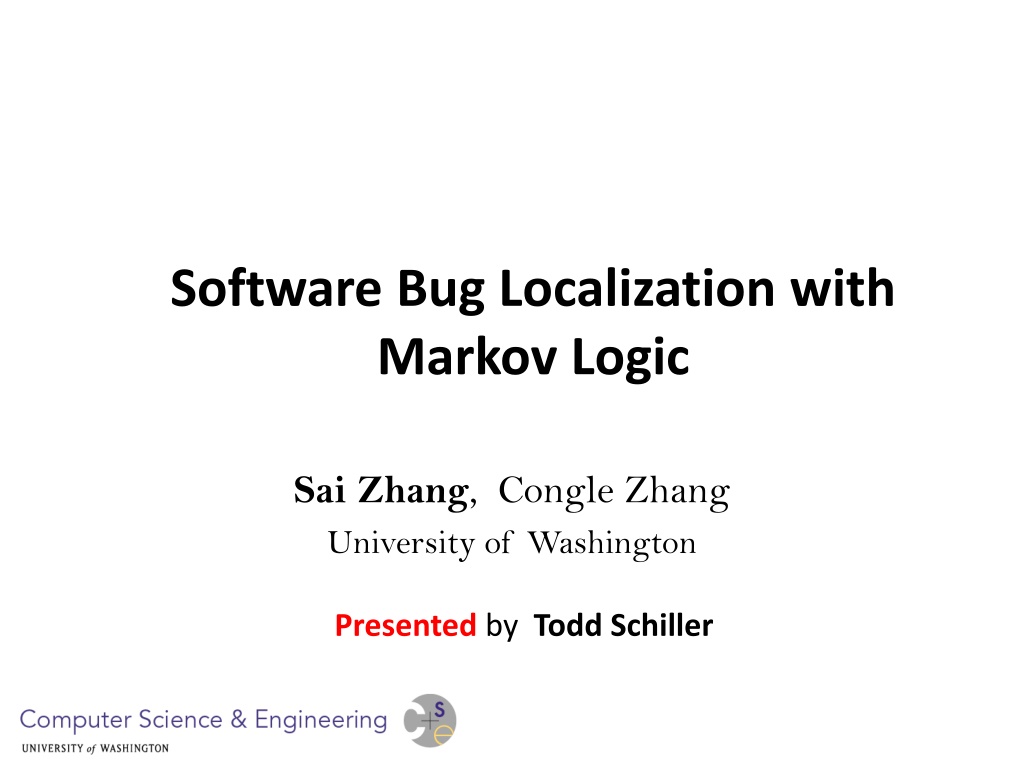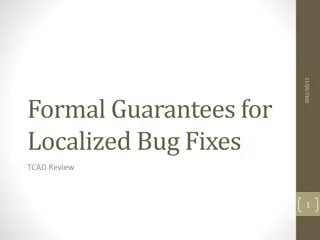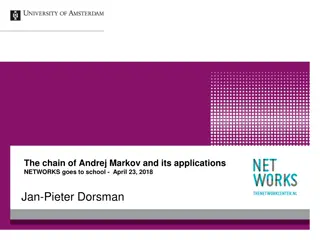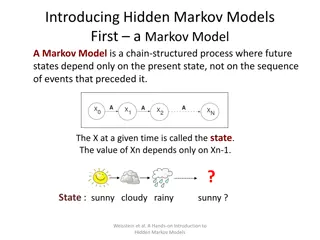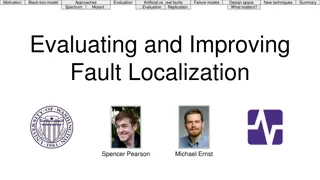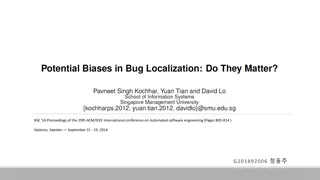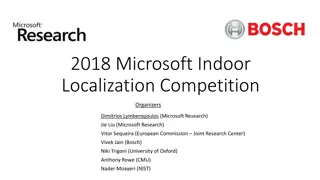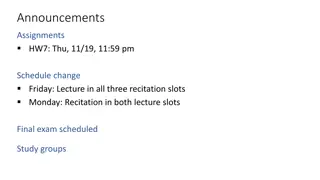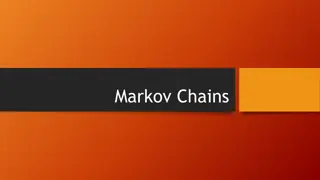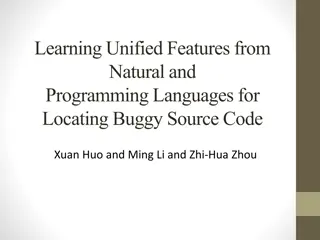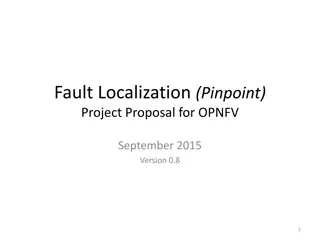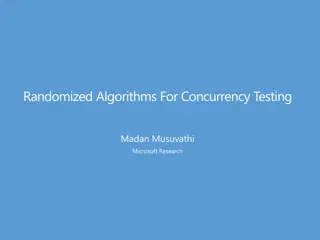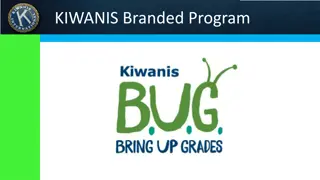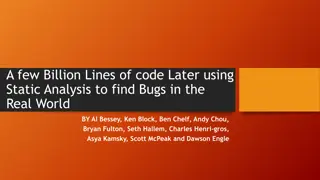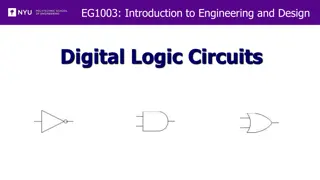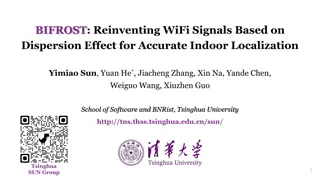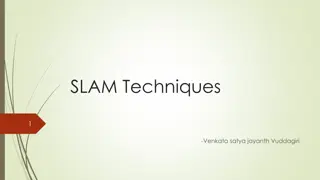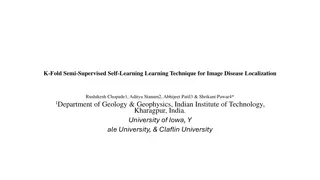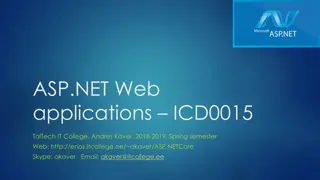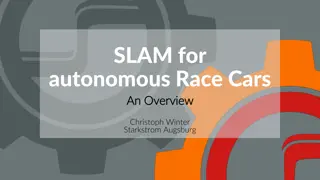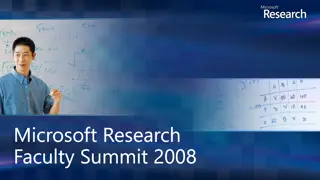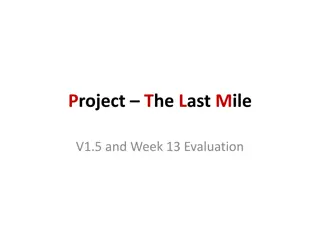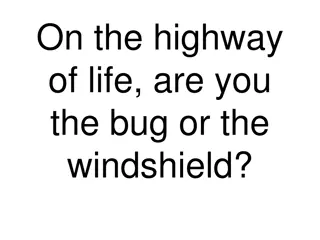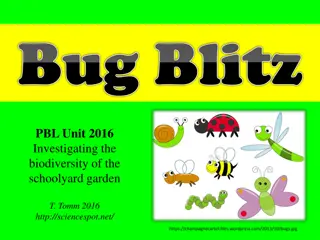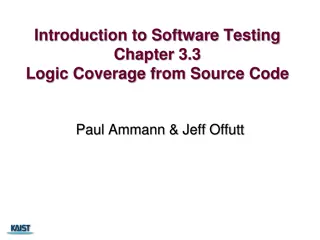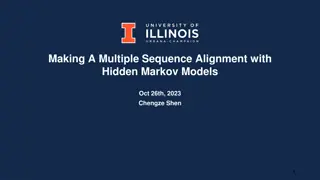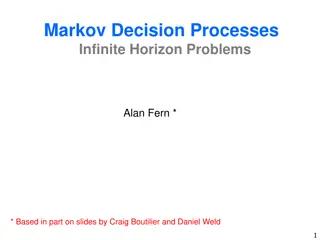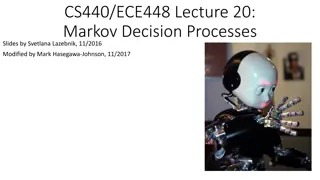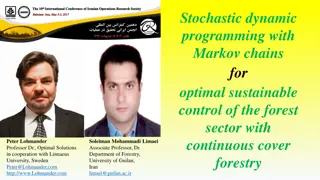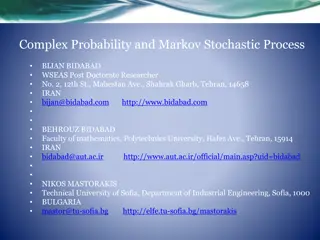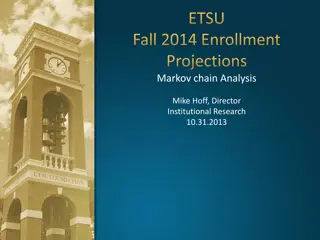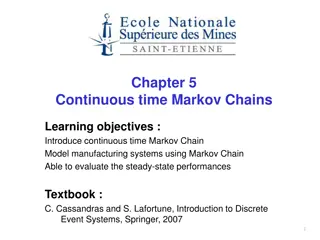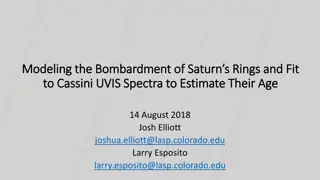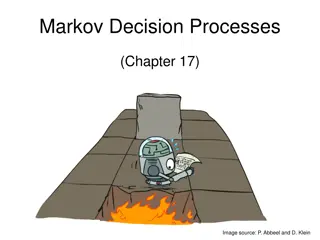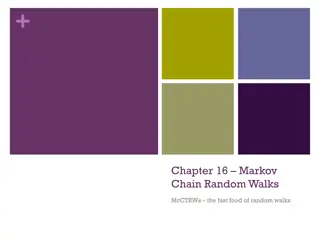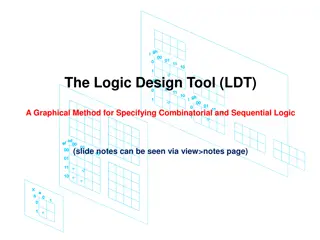Software Bug Localization with Markov Logic
Software bug localization techniques like Tarantula focus on finding likely buggy code fragments in a software system by analyzing test results, code coverage, bug history, and code dependencies. The lack of an interface layer in existing techniques leads to handcrafted heuristics, posing a persistent problem in the research community. Adding an interface layer can provide key design insights, avoid ad-hoc definitions, and enable fair comparisons between techniques.
Download Presentation

Please find below an Image/Link to download the presentation.
The content on the website is provided AS IS for your information and personal use only. It may not be sold, licensed, or shared on other websites without obtaining consent from the author. Download presentation by click this link. If you encounter any issues during the download, it is possible that the publisher has removed the file from their server.
E N D
Presentation Transcript
Software Bug Localization with Markov Logic Sai Zhang, Congle Zhang University of Washington Presented by Todd Schiller
Software bug localization: finding the likely buggy code fragments A software system (source code) Some observations (test results, code coverage, bug history, code dependencies, etc.) A ranked list of likely buggy code fragments
An example bug localization technique (Tarantula [Jones 03]) Input: a program + passing tests + failing tests Output: a list of buggy statements 3. if (a >= b) { 4. return b; 1. a = arg1 2. b = arg2 5. } else { 6. return a; Tests Example: arg1 = 2 arg2 = 1 arg1 = 2 arg2 = 2 arg1 = 1 arg2 = 2 max(arg1, arg2) { 1. a = arg1 2. b = arg2 3. if (a b) { 4. return b; 5. } else { 6. return a; 7. } } >= <
Tarantulas ranking heuristic For a statement: s %????(?) Suspiciousness(s) = %???? ? + %????(?) Percentage of failing tests covering statement s Percentage of passing tests covering statement s This heuristic is effective in practice [Jones 05]
Problem: existing techniques lack an interface layer Heuristics are hand crafted Techniques are often defined in an ad-hoc way A persistent problem in the research community Tarantula Jones ICSE 03 xDebug CBI Raul ICSE 09 Wang ICSE 09 Techniques Liblit PLDI 05 Wong, Compsac 07 Static Code Info Line Branch coverage Def-use relations Predicate Observations coverage
Adding an interface layer Tarantula Jones ICSE 03 Why an interface layer? Focus on key design insights Avoid magic numbers in heuristics Fair basis for comparison Fast prototyping xDebug CBI Raul ICSE 09 Wang ICSE 09 Liblit PLDI 05 Wong, Compsac 07 Interface layer Static Code Info Line Branch coverage Def-use relations Predicate coverage
Who should be the interface layer? Tarantula Jones ICSE 03 xDebug CBI Raul ICSE 09 Wang ICSE 09 Liblit PLDI 05 Wong, Compsac 07 Static Code Info Line Branch coverage Def-use relations Predicate coverage
Markov logic network as an interface layer Tarantula Jones ICSE 03 xDebug CBI Raul ICSE 09 Wang ICSE 09 Liblit PLDI 05 Wong, Compsac 07 Markov Logic Network Static Code Info Line Branch coverage Def-use relations Predicate coverage
Why Markov Logic Network [Richardson 05]? Use first order logic to express key insights E.g., estimate the likelihood of cancer(x) for people x Example rules: smoke(x) => cancer(x) smoke(x) friend(x,y) => smoke(y) friends(x, y) friends(y, z) => friends(x, z) smoke causes cancer you will smoke if your friend smokes friends of friends are friends
Why Markov Logic Network [Richardson 05]? Use first order logic to express key insights E.g., estimate the likelihood of cancer(x) for people x Example rules: smoke(x) => cancer(x) smoke(x) friend(x,y) => smoke(y) friends(x, y) friends(y, z) => friends(x, z) w3 w1 w2 Efficient weight learning and inference Learning rule weights from training data Estimate cancer(x) for a new data point (details omitted here)
Markov logic for bug localization Training data First-order logic rules (capture insights) Alchemy (learning) Researchers A markov logic network engine Rule weights Alchemy (inference) Likelihood of s being buggy A statement: s
Markov logic for bug localization Different rules for different bug localization algorithms Training data First-order logic rules Alchemy (learning) Researchers A markov logic network engine Rule weights Alchemy (inference) Likelihood of s being buggy A statement: s
Our prototype: MLNDebugger First-order rules 1. cover(test, s) fail(test) => buggy(s) 2. cover(test, s) pass(test) => buggy(s) 3. control_dep(s1, s2) buggy(s1) => buggy(s2) 4. data_dep(s1, s2) buggy(s1) => buggy(s2) 5. wasBuggy(s) => buggy(s) failing test is buggy If a statement has control dependence on a buggy statement, then it is not buggy dependence on a buggy statement, then it is not buggy before is buggy Buggy! if(foo(x)) { bar(); } A statement covered by a A statement covered by a passing test is not buggy Learning and inference If a statement has data flow v = foo() bar(v) Buggy! Rules + Weights A statement that was buggy A statement: stmt Correct! Buggy! Correct! Correct! How likely stmt is buggy
Evaluating MLNDebugger on 4 Siemens benchmarks 80+ seeded bugs 2/3 as training set 1/3 as testing set Measurement on the testing set Return topk suspicious statements, check the percentage of buggy ones they can cover. Baseline: Tarantula [Jones ICSE 2003]
Experimental results MLNDebugger Tarantula
More in the paper Formal definition Inference algorithms Implementation details Implications to the bug localization research
Contributions The first unified framework for automated debugging Markov logic network as an interface layer: expressive, concise, and elegant A proof-of-concept new debugging technique using the framework An empirical study on 4 programs 80+ versions, 8000+ tests Outperform a well-known technique
